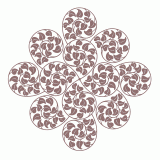When we came across this design pattern, we found it quite interesting and immediately decided to draw it for you. At first glance, it seems rather complicated, but if you take a closer look, it actually consists of one single motif that is repeated 12 times, and then the 12 obtained motifs are arranged in a specific way. Thus, the book binder was supposed to make a much simpler finishing tool because only one design element was to be engraved onto it - the basic motif, actually, and the whole decoration was obtained by precise impressing the finishing tool as many as 12 times.
The basic motif of this design pattern, as you can see, is a simple scroll decorated with leaves. Should you have any extra ideas, you could easily change this pattern by drawing a slightly different scroll, drawing different leaves, adding flowers among the leaves or arranging scrolls in a different way. For example, just by deleting 8 external motifs you will get a completely different pattern consisting of only 4 copies of the basic motif. You could arrange the basic motif, for example, around the drawn circle and make a rectangle border. In other words, if you come up with creative ideas, you can easily and quickly draw a large number of different design patterns. Surely you need to know how to use some 2D CAD or vector software so that this process can be significantly accelerated.
